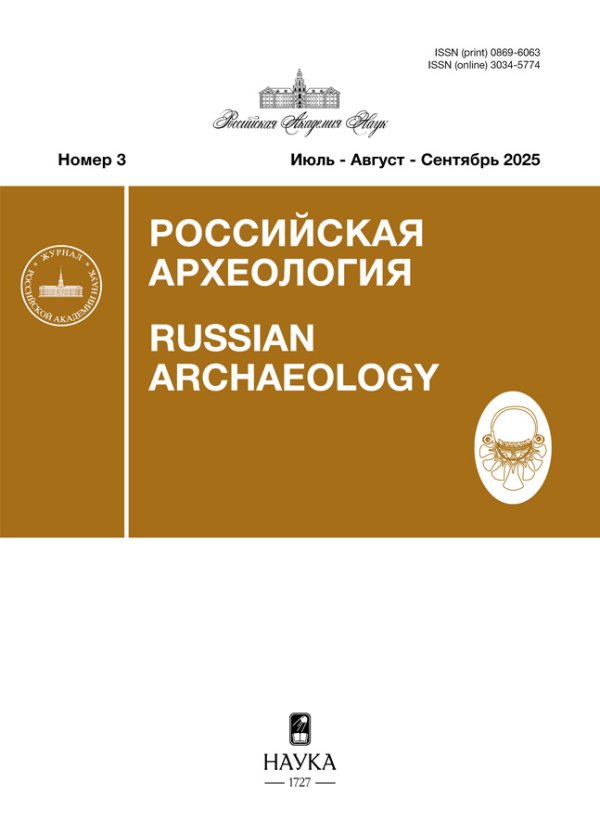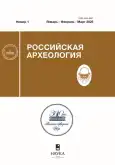The problem of distribution of Sioni type pottery in the South Caucasus in the context of archaeological excavations in the Tumbultepe settlement
- Authors: Bakhshaliyev V.B.1, Ceylan N.2, Bakhshaliyev E.3, Hasanova H.3
-
Affiliations:
- Nakhchivan State University
- Kyrgyz-Turkish Manas University
- Nakhchivan Branch of the National Academy of Sciences of Azerbaijan
- Issue: No 1 (2025)
- Pages: 21-36
- Section: ARTICLES
- URL: https://journal-vniispk.ru/0869-6063/article/view/306867
- DOI: https://doi.org/10.31857/S0869606325010027
- EDN: https://elibrary.ru/bhmkbq
- ID: 306867
Cite item
Abstract
Many Caucasian scholars give a general name to the Late Chalcolithic culture of the South Caucasus: it is sometimes referred to as the Sioni culture, sometimes as the Sioni-Tsopi culture, sometimes as the Sioni ceramics, and sometimes as the Sioni-Tsopi-Ginchi culture. However, Sioni type pottery is very rare in the settlements of Nakhchivan. The study of material and cultural samples, especially the pottery from the newly excavated settlement of Tumbultepe and other sites of Nakhchivan, is vitally important for clarifying issues related to the Late Chalcolithic cultures of the South Caucasus, including the Sioni culture. Even if it is possible to refer to a group of Late Chalcolithic sites in the South Caucasus as to the Sioni-Tsopi-Ginchi culture, the authors believe it is not correct to attribute this to all the sites of the South Caucasus.
Keywords
About the authors
V. B. Bakhshaliyev
Nakhchivan State University
Author for correspondence.
Email: velibahshaliyev@mail.ru
Azerbaijan
N. Ceylan
Kyrgyz-Turkish Manas University
Email: n.ceylan@atauni.edu.tr
Bishkek, Kyrgyz Republic
E. Bakhshaliyev
Nakhchivan Branch of the National Academy of Sciences of Azerbaijan
Email: elmarbakhshaliev@gmail.com
H. Hasanova
Nakhchivan Branch of the National Academy of Sciences of Azerbaijan
Email: h.hasanova.99@mail.ru
References
- Abedi A., Khatib Shahidi H., Chataigner Ch. et al., 2014. Excavation at Kul Tepe of (Jolfa), North-Western Iran, 2010: First Preliminary Report. Ancient Near Eastern Studies, 51, pp. 33–165.
- Abibullaev O.A., 1982. Eneolit i bronza na territorii Nakhichevanskoy ASSR [The Eneolithic and Bronze Age on the territory of the Nakhichevan Autonomous Soviet Socialist Republic]. Baku: Nauka. 316 p.
- Acar G.Z., 2021. Naxçıvan və Şərqi Anadolunun Son Eneolit mədəniyyəti. Naxçıvan: Tusi. 32 p.
- Akhundov Т. I., 2017. U istokov Kavkazskoy tsivilizatsii. Neolit Azerbaydzhana. Pamyatniki traditsii Garabagskogo neolita [At the origins of the Caucasian civilization. The Neolithic of Azerbaijan. Sites of the Qarabag Neolithic tradition]. Baku: Afpoligraf. 918 p.
- Aliev N., Narimanov I., 2001. Kul’tura severnogo Azerbaydzhana v epokhu pozdnego eneolita [Culture of northern Azerbaijan in the late Eneolithic]. Baku: Agrydag. 144 p.
- Arkheologiya Vengrii (Kamennyy vek) [Archaeology of Hungary (Stone Age)]. V.S. Titov, I. Erdeli, M. Gabori, eds. Moscow: Nauka, 1980. 420 p.
- Badalyan R., Harutyunyan A., Chataıgner Ch. et al., 2010. The Settlement of Aknashen-Khatunarkh, A Neolitic Site in the Ararat Plain (Armenia): Excavation Results 2004–2009. TUBA-AR: Türkiye Bilimler Akademisi arkeoloji dergisi, 13, pp. 185–218.
- Bakhshaliev V.B., 2013. Proto Kura-Araxes ceramics of Nakhchivan. Rossiyskaya arkheologiya [Russian archaeology], 3, pp. 105–107. (In Russ.)
- Bakhshaliev V.B., 2014. New Chalcolithic sites on the territory of Nakhchivan. Rossiyskaya arkheologiya [Russian archaeology], 2, pp. 88–95. (In Russ.)
- Bakhshaliev V.B., 2019. Archaeological research of the settlement of Nakhchivan Tepe. Rossiyskaya arkheologiya [Russian archaeology], 2, pp. 96–109. (In Russ.)
- Bakhshaliev V.B., 2022. Archaeological excavations at the settlement of Kültepe I. Rossiyskaya arkheologiya [Russian archaeology], 1, pp. 139–152. (In Russ.)
- Bakhshaliyev V., 2022. Archaeology of Nakhchivan in the light new discoveries. Nakhchivan: Ajami. 372 p.
- Baxşəliyev V., Marro C., Aşurov S., 2010. Ovçulartəpəsi. Bakı: Elm. 156 p.
- Camps G., Rostan E., 1982. Les poteries à perforations en ligne, à propos du faciès terrinien du Chalcolithique corse. Bulletin de la Société préhistorique française, 79, 8, pp. 240–249.
- Cherlenok E.A., 2013. Arkheologiya Kavkaza (mezolit, neolit, eneolit): uchebno-metodicheskoe posobie [Archaeology of the Caucasus (Mesolithic, Neolithic, Eneolithic): study guide]. St. Petersburg. 54 p.
- Derin Z., Caymaz T., 2017. The Chalcolithic period at Yeşilova Höyük. Communities in transition: the Circum Aegean area during the 5th and 4th millennia BC. S. Dietz, eds. Oxford: Oxbow Books, pp. 499–505.
- Dzhaparidze O., 1989. Na zare etnokul’turnoy istorii Kavkaza [At the dawn of the ethnocultural history of the Caucasus]. Tbilisi: Izdatel’stvo Tbilisskogo universiteta. 423 p.
- Emre E., 2017. MÖ 5. ve 4. Binyıl Nahçıvan Mangaly Kapları: Yüksek Lisans Tezi. İzmir. 310 p.
- Esin U., 1993. The relief decorations on the Prehistoric pottery of Tülintepe in Eastern Anatolia. Between the Rivers and over the Mountains. M. Frangipane, ed. Roma: Università di Roma “La Sapienza”, pp. 105–122.
- Gülçur S., Marro C., 2012. The view from the north: comparative analysis of the Chalcolithic pottery assemblages from Norşuntepe and Ovçular Tepesi. After the Ubaıd: Interpreting Change from the Caucasus to Mesopotamia at the Dawn of Urban Civilization (4500–3500 BC). Paris: De Boccard, pp. 305–352.
- Kiguradze T., Sagona A., 2003. On the origins of the Kura-Araxes cultural complex. Archaeology in the Borderlands: Investigations in Caucasia and Beyond. A.T. Smith, K. Rubinson, eds. Los Angeles: Cotsen Institute of Archaeology, University of California, pp. 38–94.
- Kiguradze T., 2000. The Chalcolithic-Early Bronze transition in the Eastern Caucasus. Chronologies des Pays du Caucase et de l’Euphrate aux IVe–IIIe millénaires. C. Marro, H. Hauptmann, eds. Istanbul: Institut Français d’Études Anatoliennes, pp. 321–328.
- Kuliyeva Z., Bahşeliyev V., 2018. Nahçıvan’ın Kalkolitik Çağ Kültürü (Azerbaycan). TUBA-AR: Türkiye Bilimler Akademisi arkeoloji dergisi, 23, pp. 29–52.
- Lyonnet B., Guliyev F., Helwing B. et al., 2012. Ancient Kura 2010–2011: The first two seasons of joint field work in the Southern Caucasus. Archäologische Mitteilungen aus Iran und Turan, 44, pp. 1–190.
- Maziar S., 2010. Excavations at Kohne Pasgah Tepesi, the Araxes Valley, the Northwest Iran: First Preliminary Report. Ancient Near Eastern Studies, 47, pp. 165–193.
- Menadbe M., Kiguradze T., 1981. Arkheologicheskie pamyatniki sela Sioni [Archaeological sites of the village of Sioni]. Tbilisi: Metsniereba. 142 p.
- Munchaev R.M., 1975. Kavkaz na zare bronzovogo veka [The Caucasus at the dawn of the Bronze Age]. Moscow: Nauka. 478 p.
- Munchaev R.M., Amirov Sh.N., 2015. The Leylatepe culture and the Caucasus. Kavkaz kak svyazuyushchee zveno mezhdu Vostochnoy Evropoy i Perednim Vostokom: dialog kul’tur, kul’tura dialoga (k 140-letiyu Aleksandra A. Millera) [The Caucasus as a link between Eastern Europe and the Near East: dialogue of cultures, culture of dialogue (to the 140th anniversary of Aleksandr A. Miller)]. St. Petersburg, pp. 128–131. (In Russ.)
- Müseyibli N., 2007. Böyük Kəsik eneolit yaşayış məskəni. Bakı: Nafta-Press. 228 p.
- Müseyibli N., 2020. Leylatəpə mədəniyyəti. Bakı: Elm və Təhsil. 576 p.
- Narimanov I.G., Akhundov Т. I., Aliev N.G., 2007. Kul’tura Leylatepe [The Leylatepe culture]. Baku: Agrydag. 128 p.
- Özfırat A., Marro C., 2007. 2004 Yılı Van, Ağrı ve İqdır İlleri Yüzey Araştırması. Türk Arkeoloji ve Etnografya Dergisi, 7, pp. 1–20.
- Palumbi G., 2007. A Preliminary Analysis on the Prehistoric Pottery from Aratashen (Armenia). Les Cultures du Caucase (VIe–IIIe millénaires avant notre ère). Leurs Relations avec le Proche-Orient. B. Lyonnet, ed. Paris: Centre national de la recherche scientifique, pp. 63–76.
- Sampson A., 1984. The Neolithic of the Dodecanese and Aegean Neolithic. The Annual of the British School at Athens, 79, pp. 239–247.
- Sharifi M., Motarjem A., 2018. The process of cultural change in the Chalcolithic period in the highlands of Western Iran at Tepe Gheshlagh. Documenta Prehistorica, XLV, pp. 86–99.
Supplementary files










